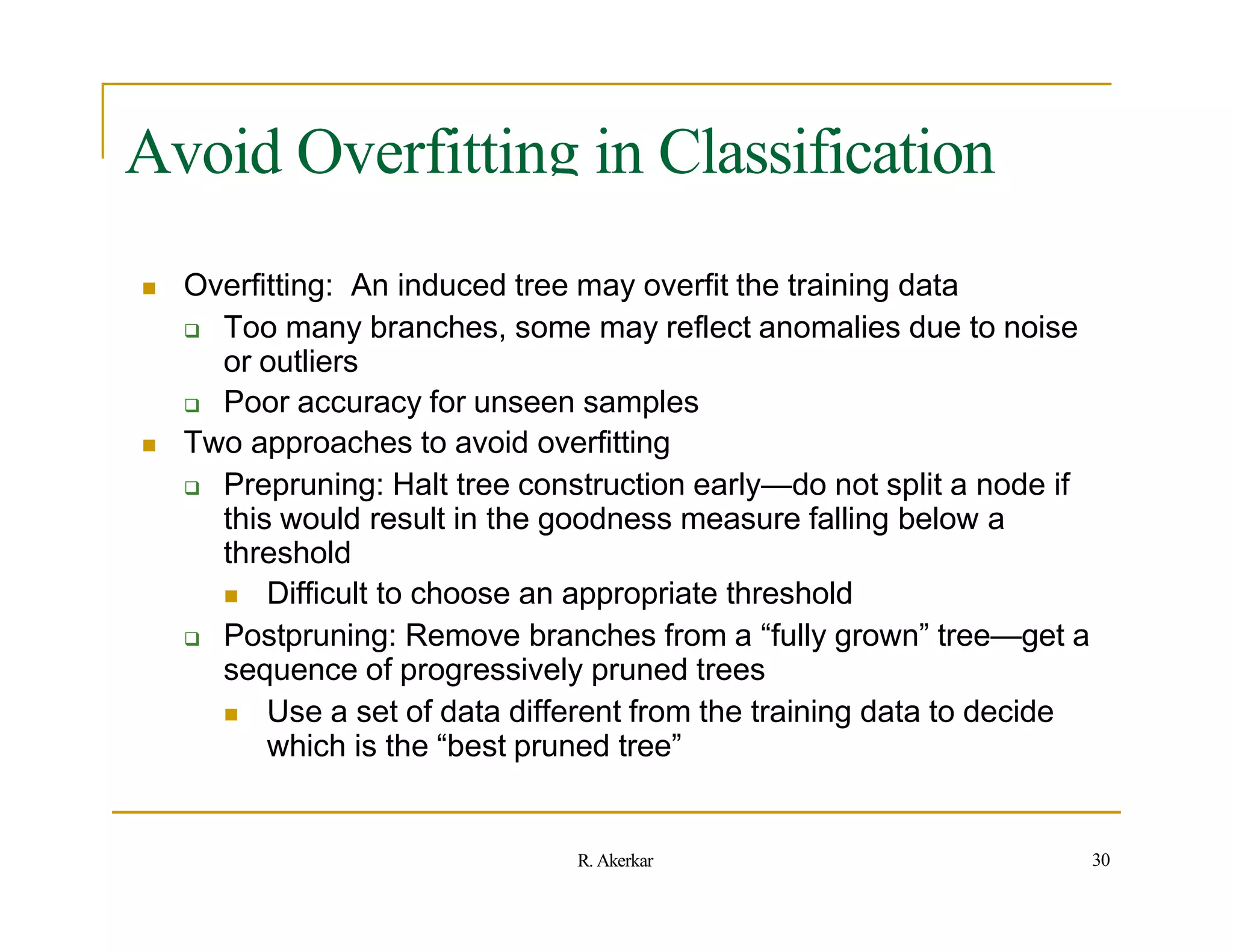Here are the steps to construct the decision tree using the Gini index approach:
1. Calculate the Gini index for the total dataset:
Gini(Total) = 1 - (19/40)2 - (21/40)2 = 0.5
2. Calculate the Gini index for age <= 50 split:
Gini(S1) = 1 - (8/19)2 - (11/19)2 = 0.3789
Gini(S2) = 1 - (11/21)2 - (10/21)2 = 0.4762
3. Calculate the Gini index for the split:
Gini(Split) = (19
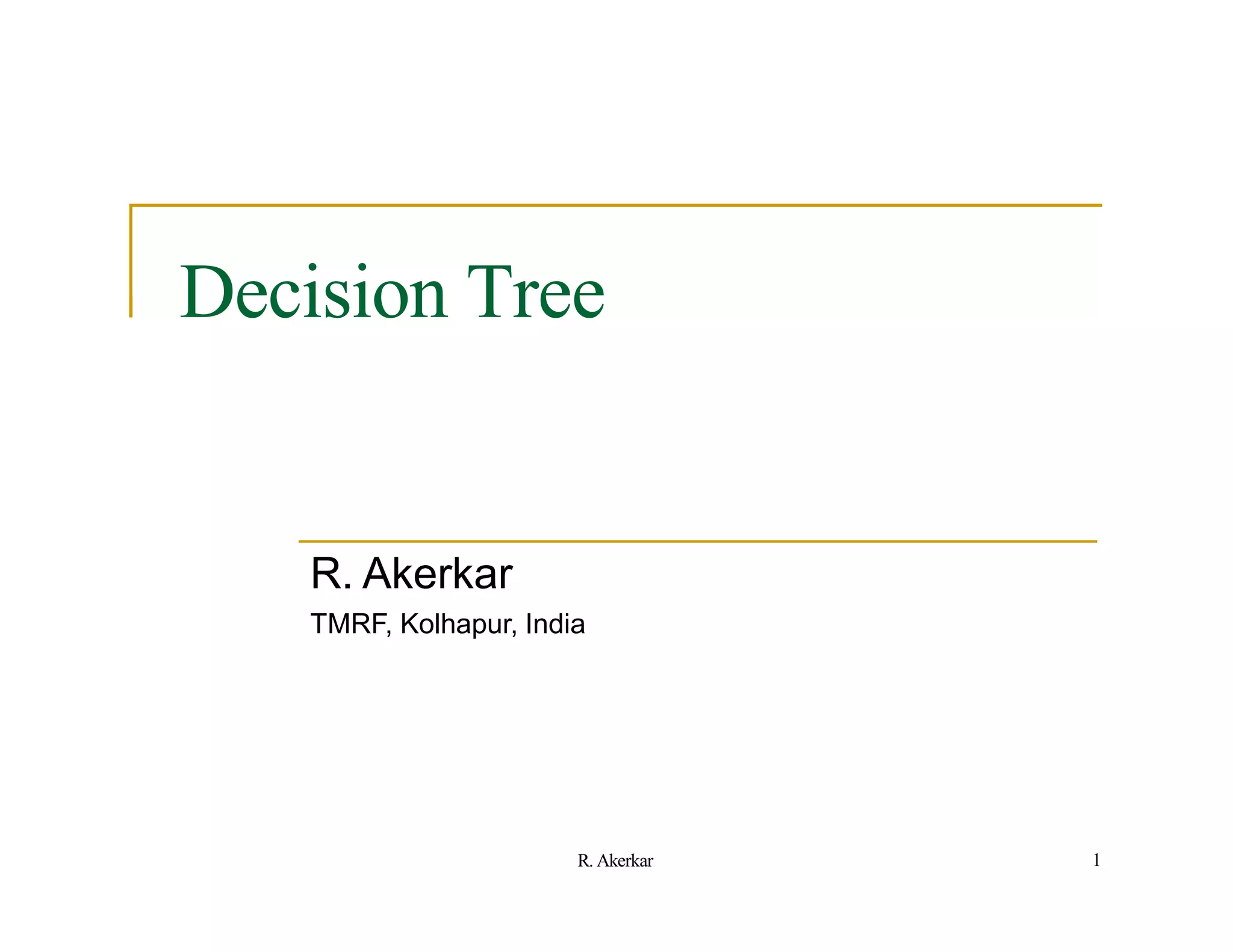
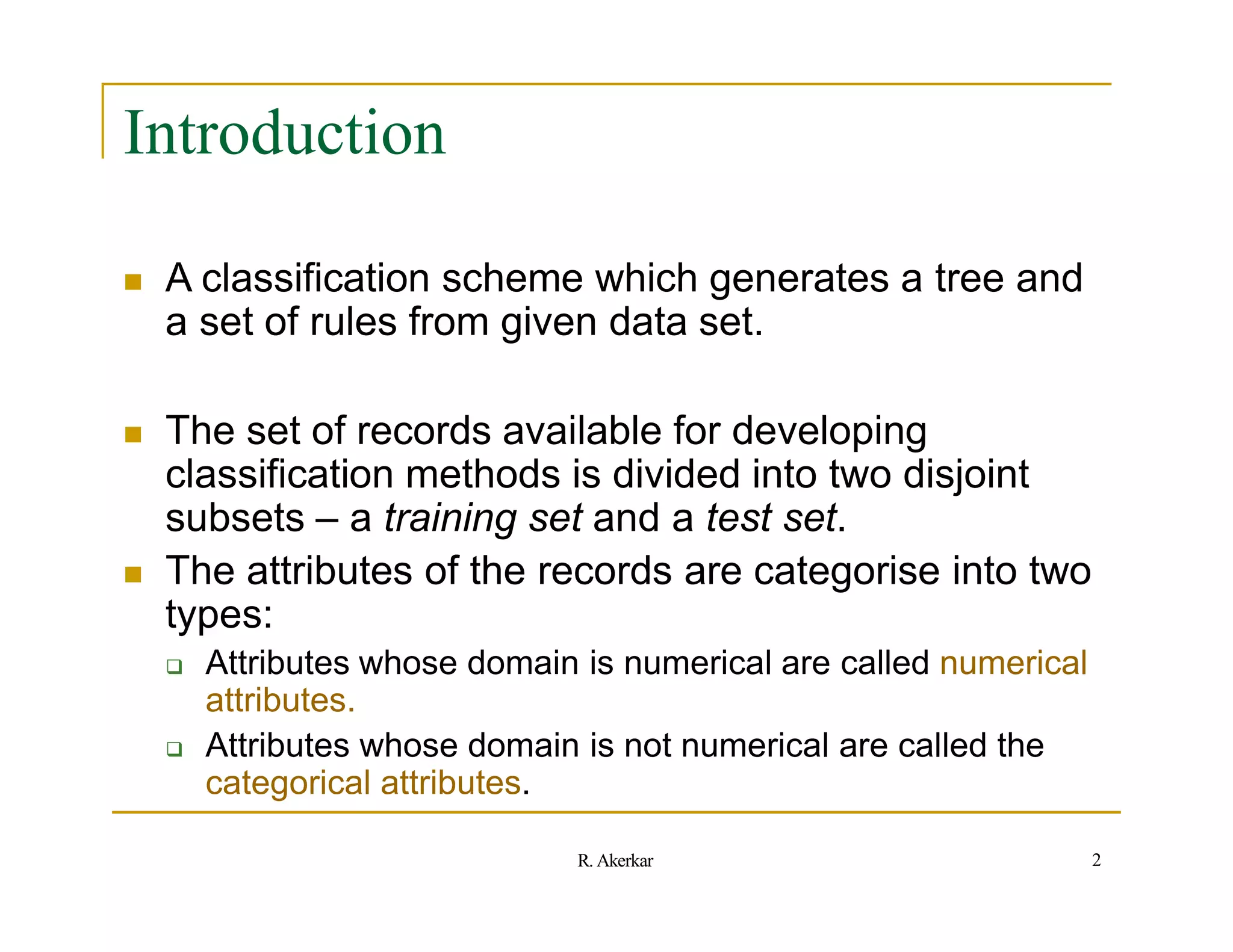
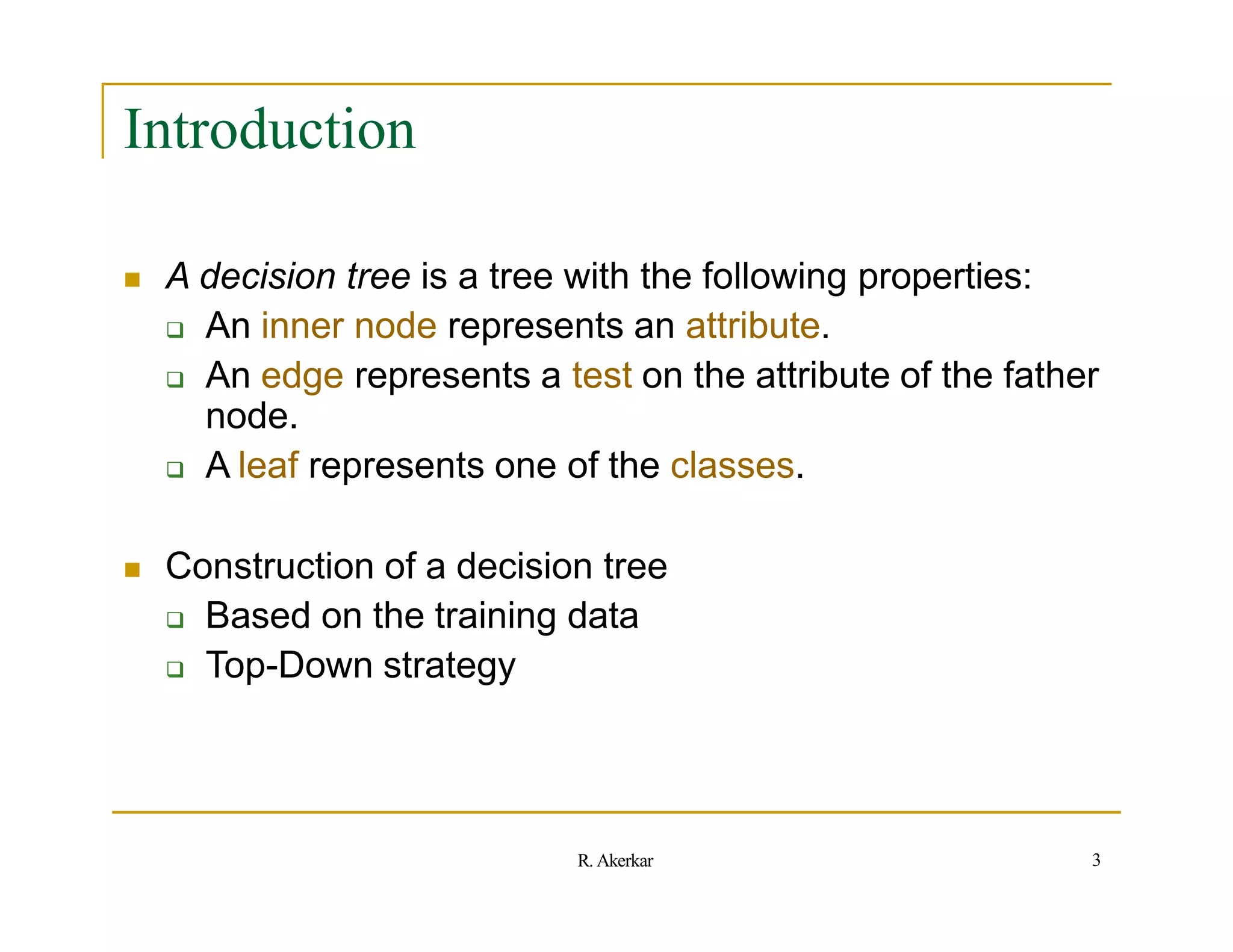

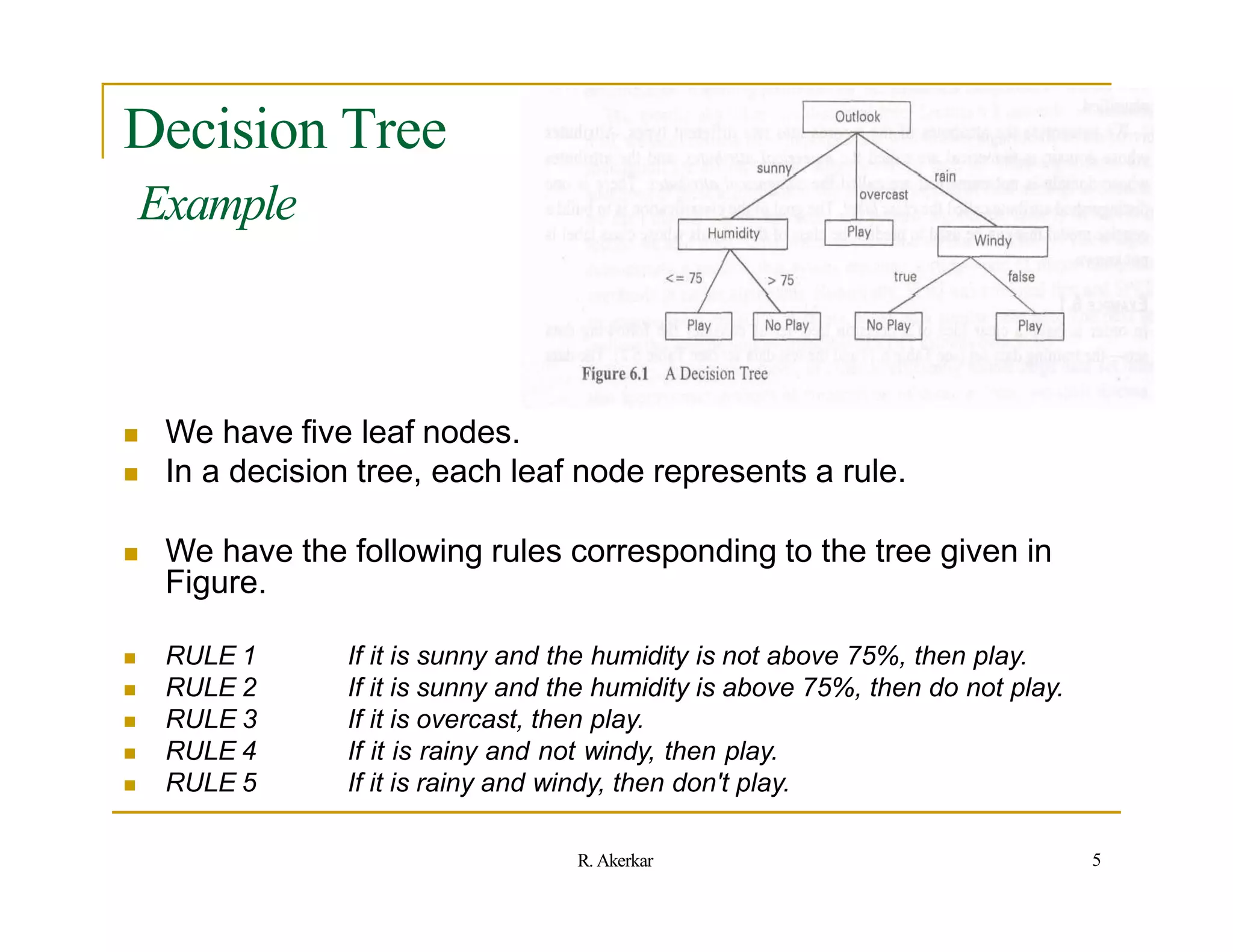
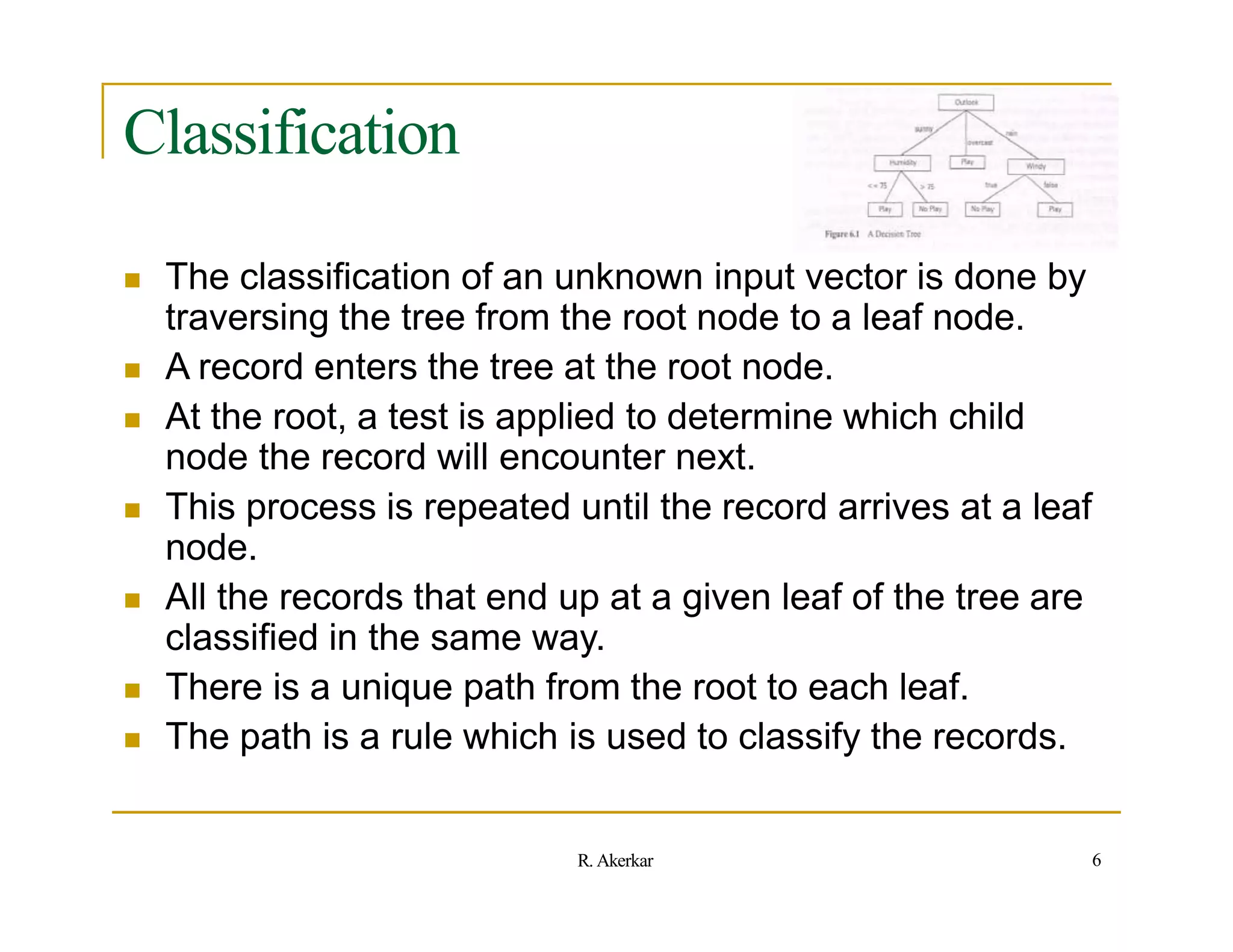
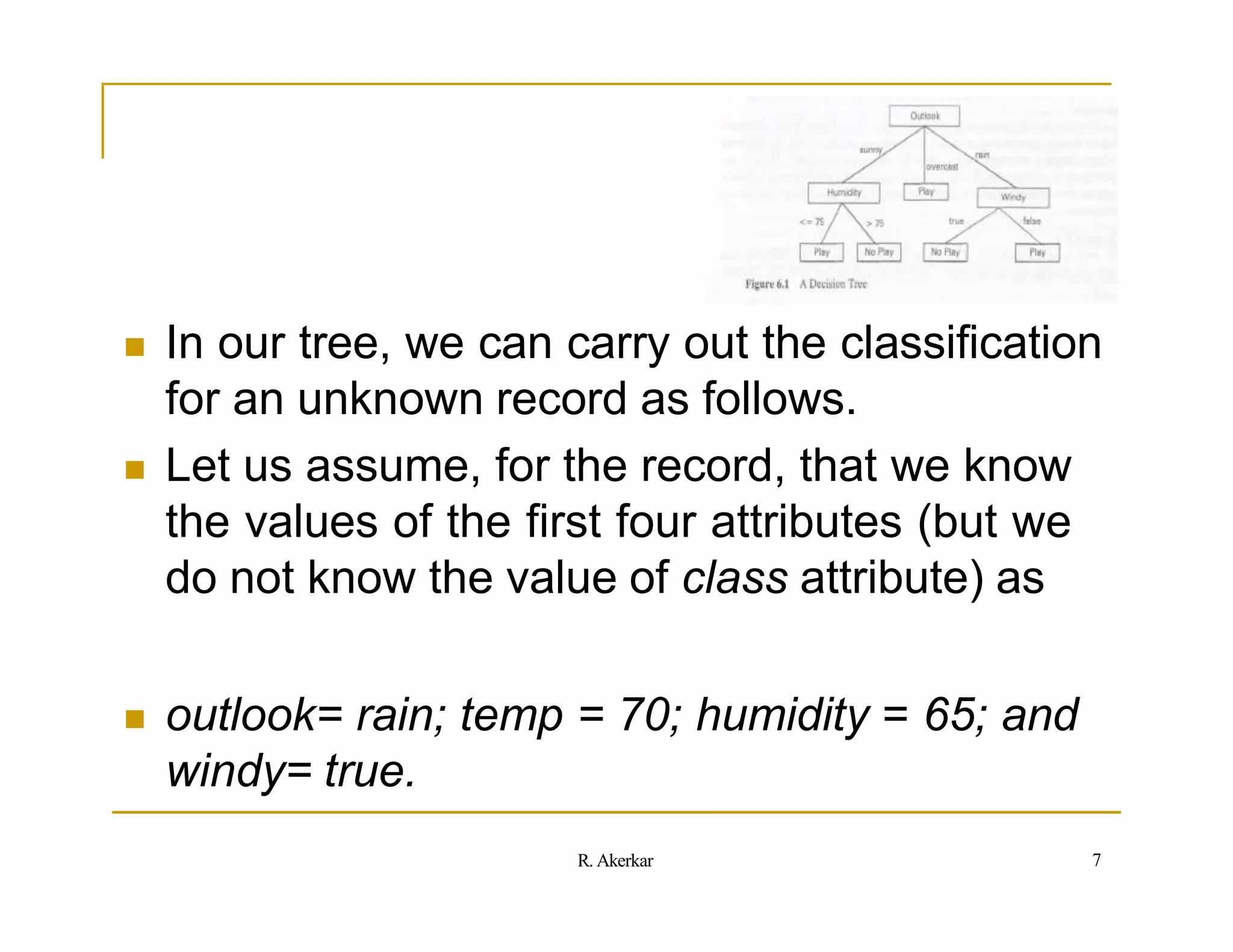
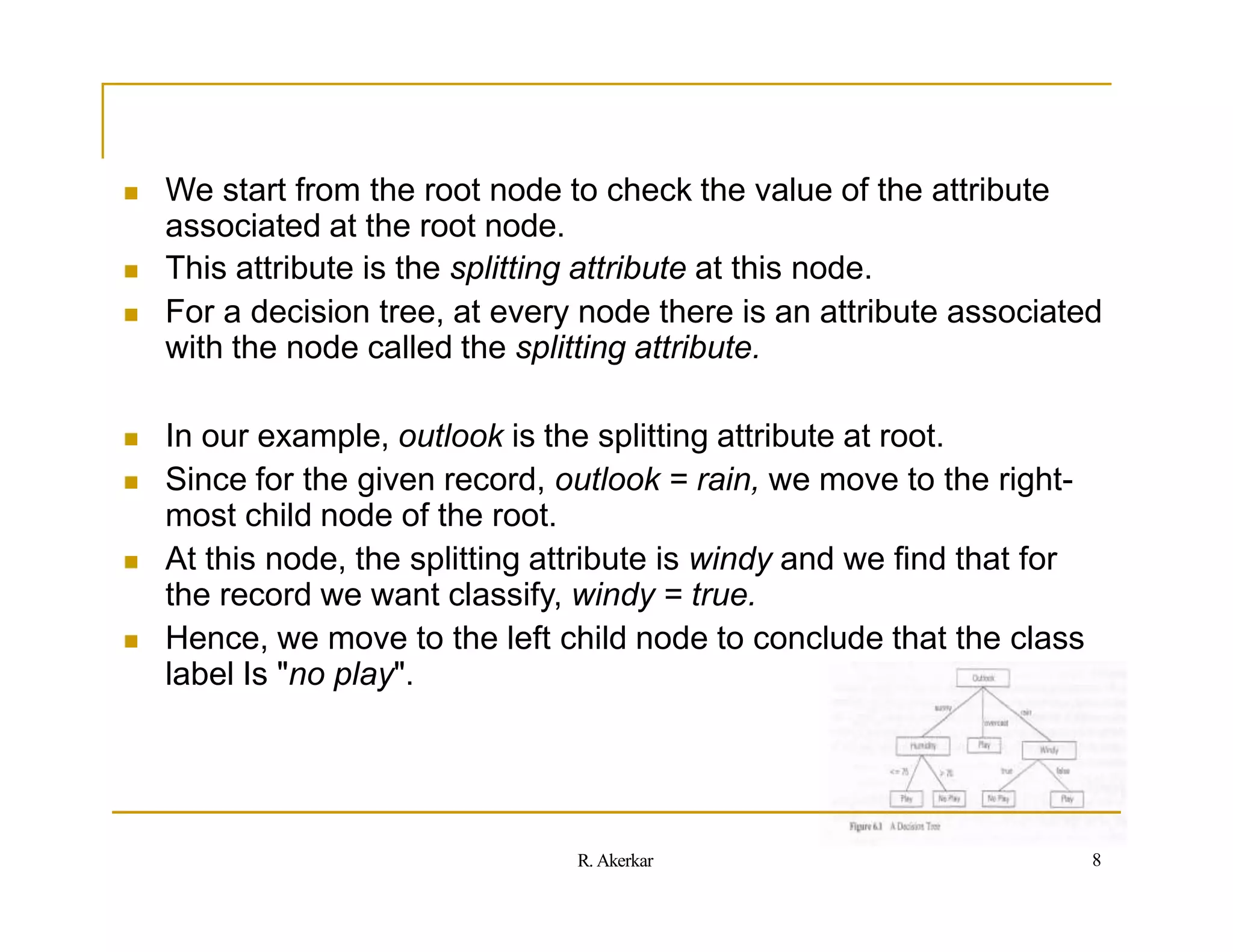
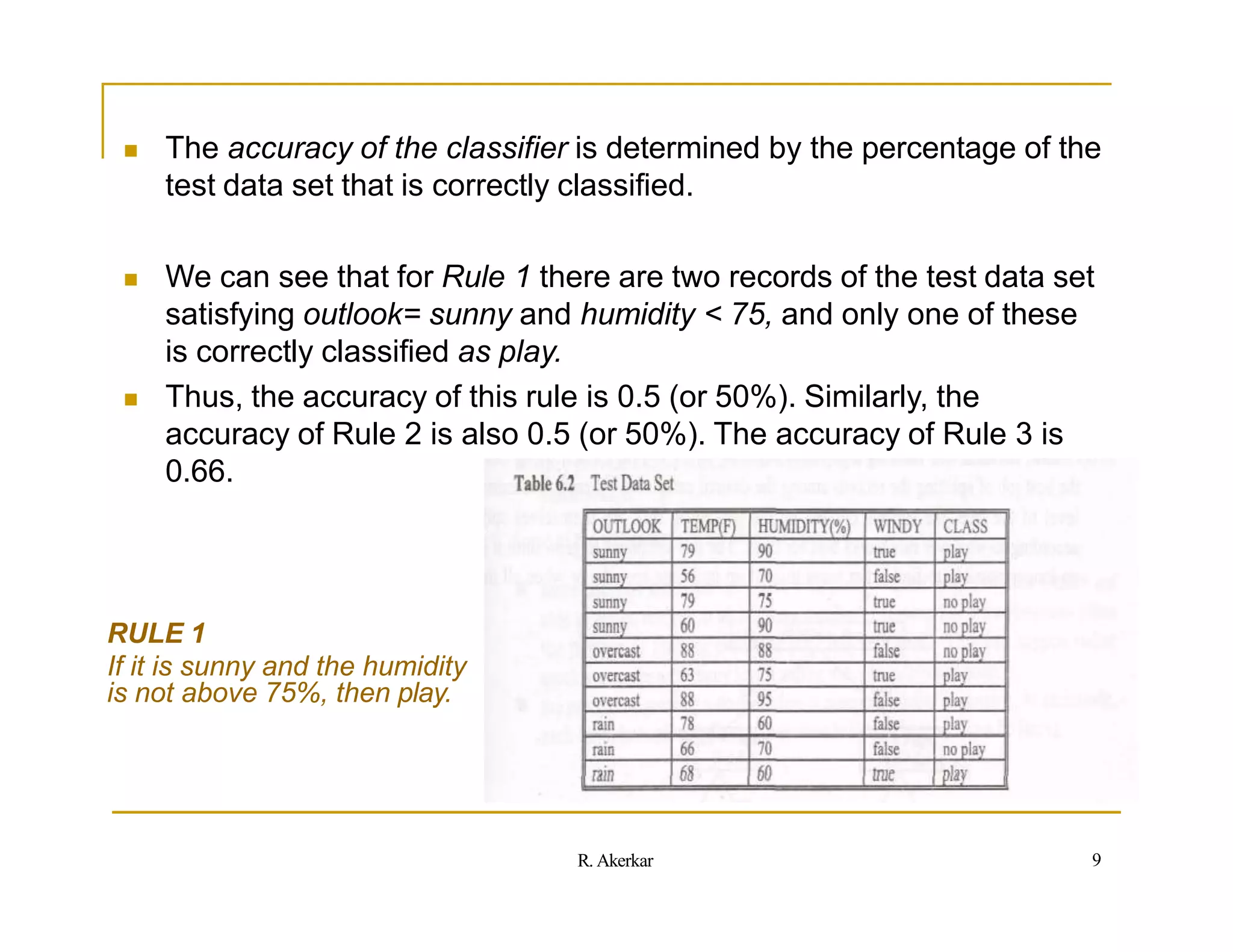
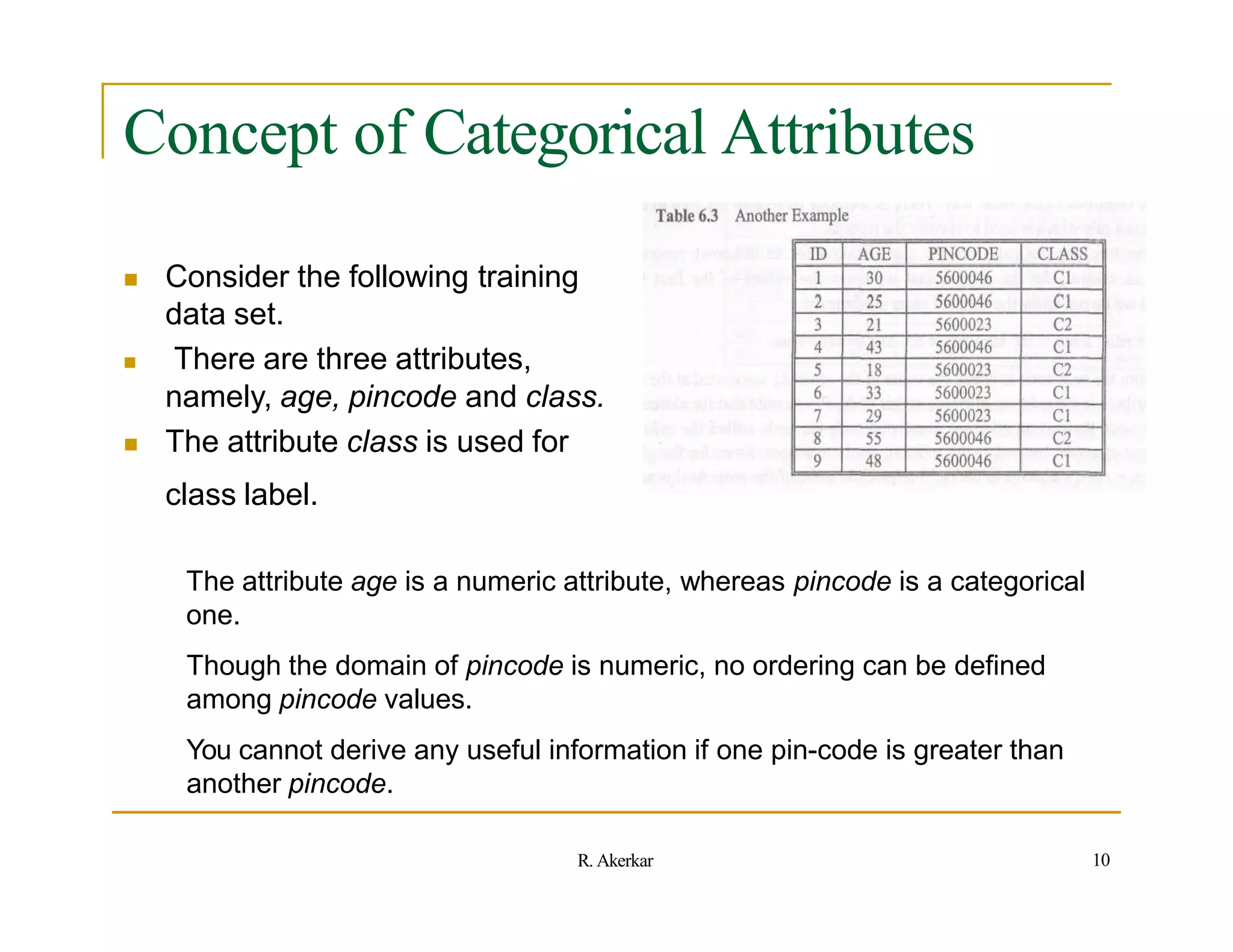

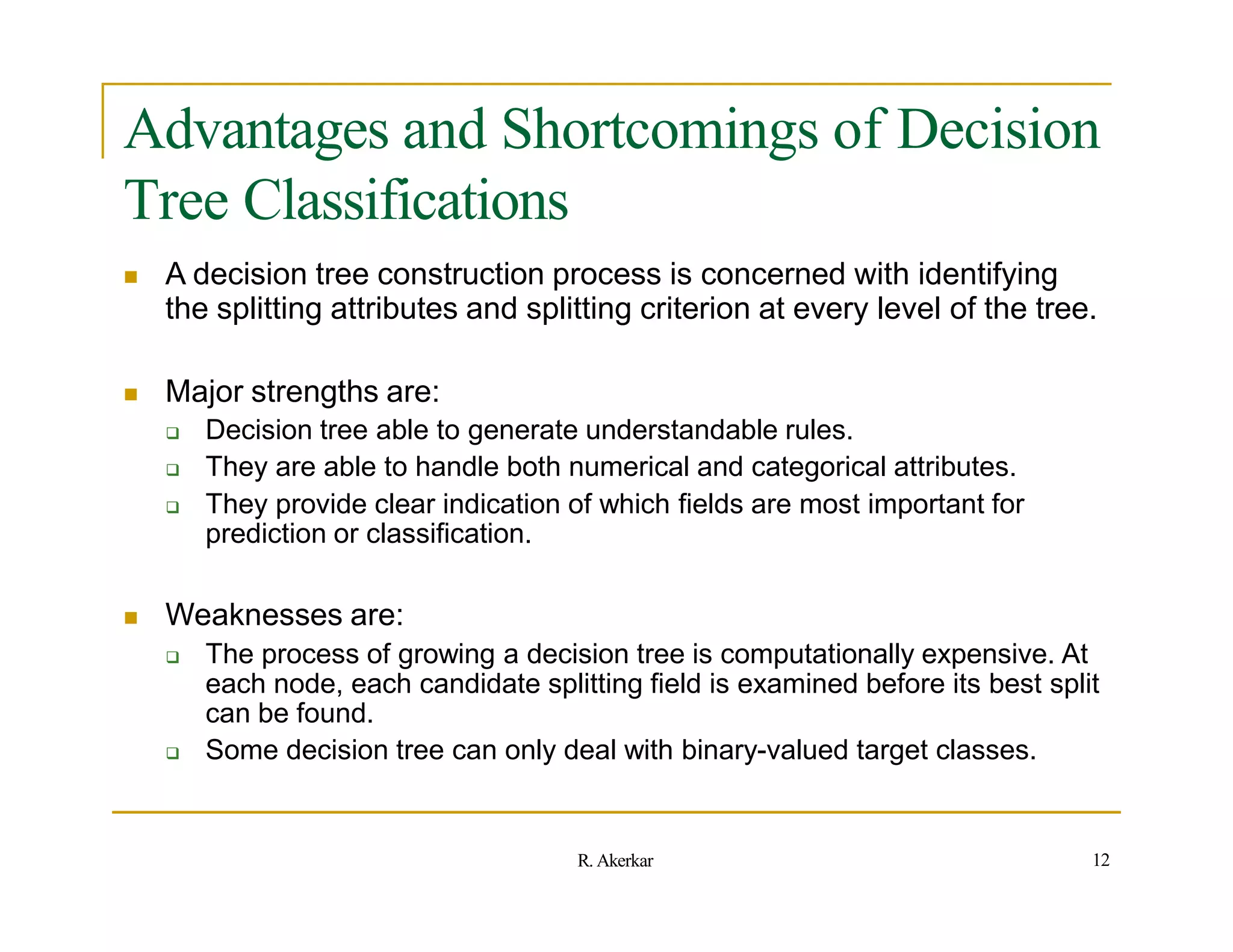
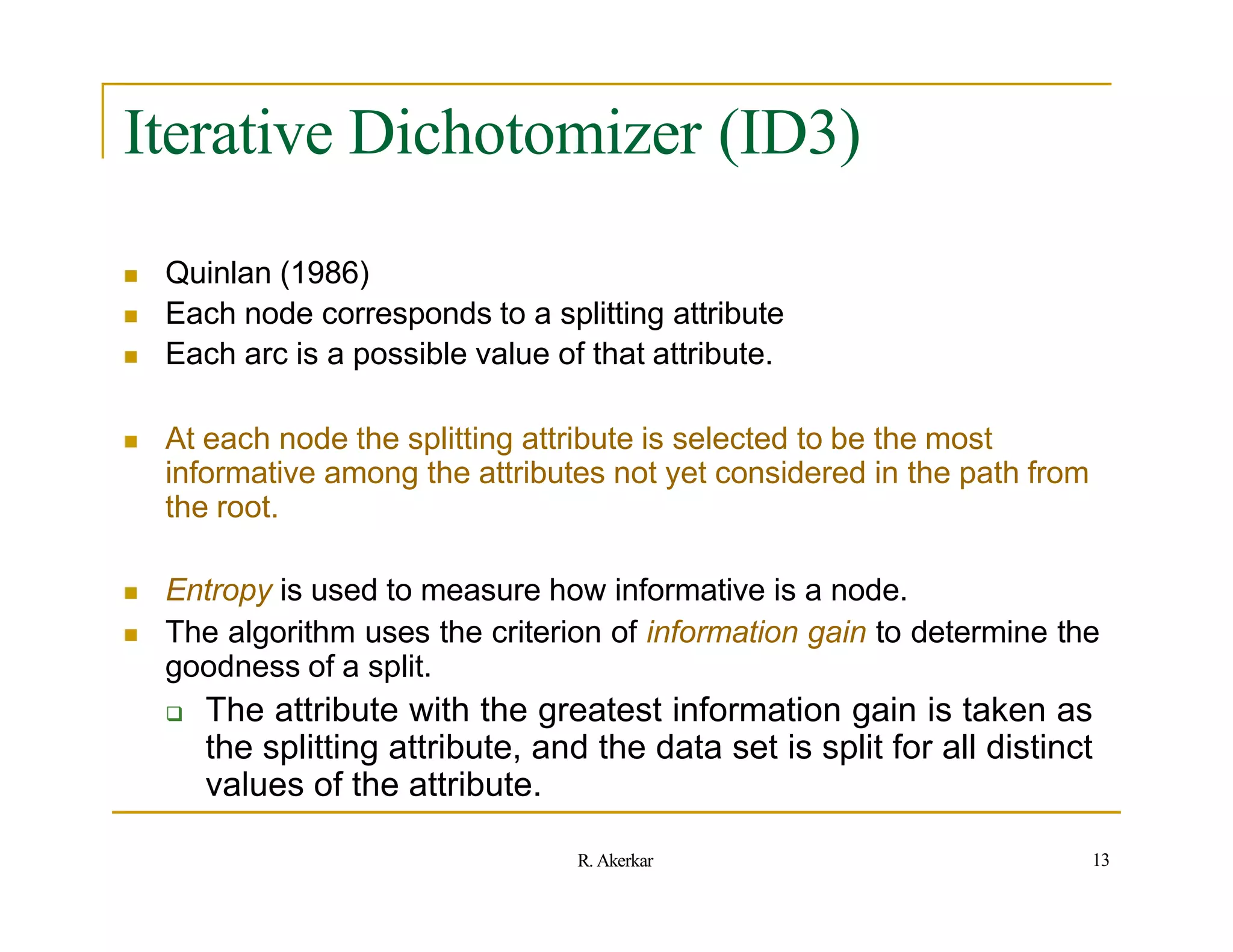
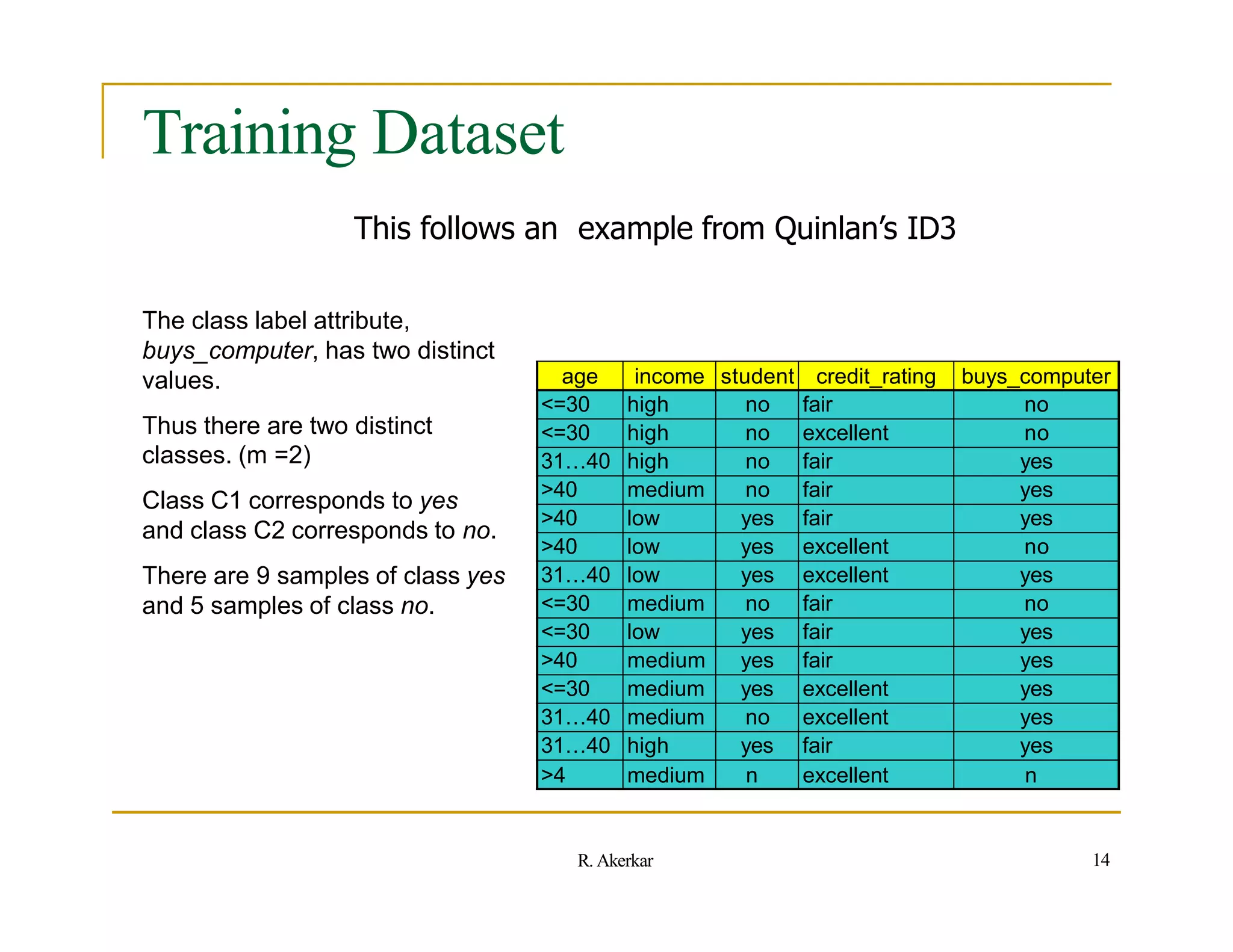
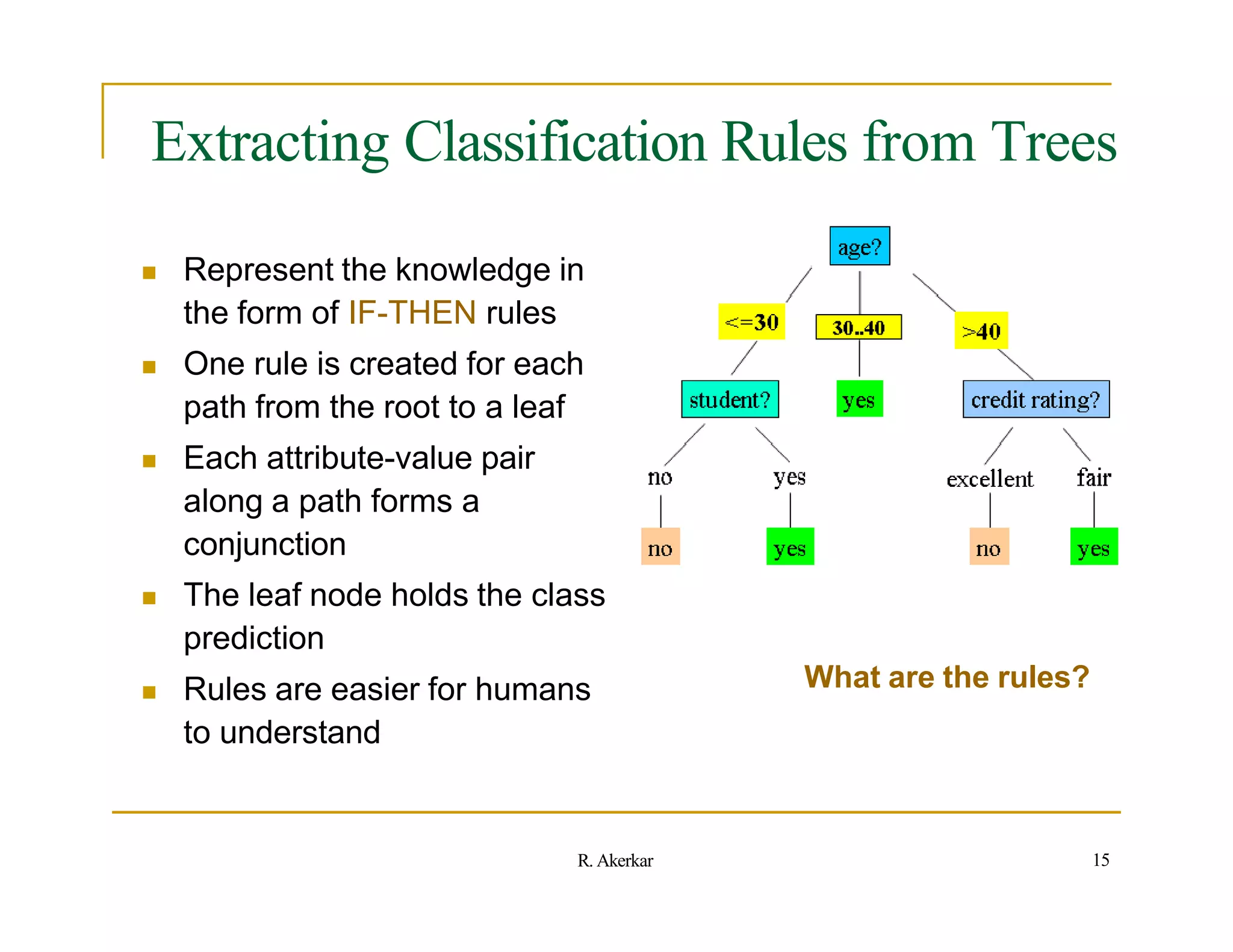
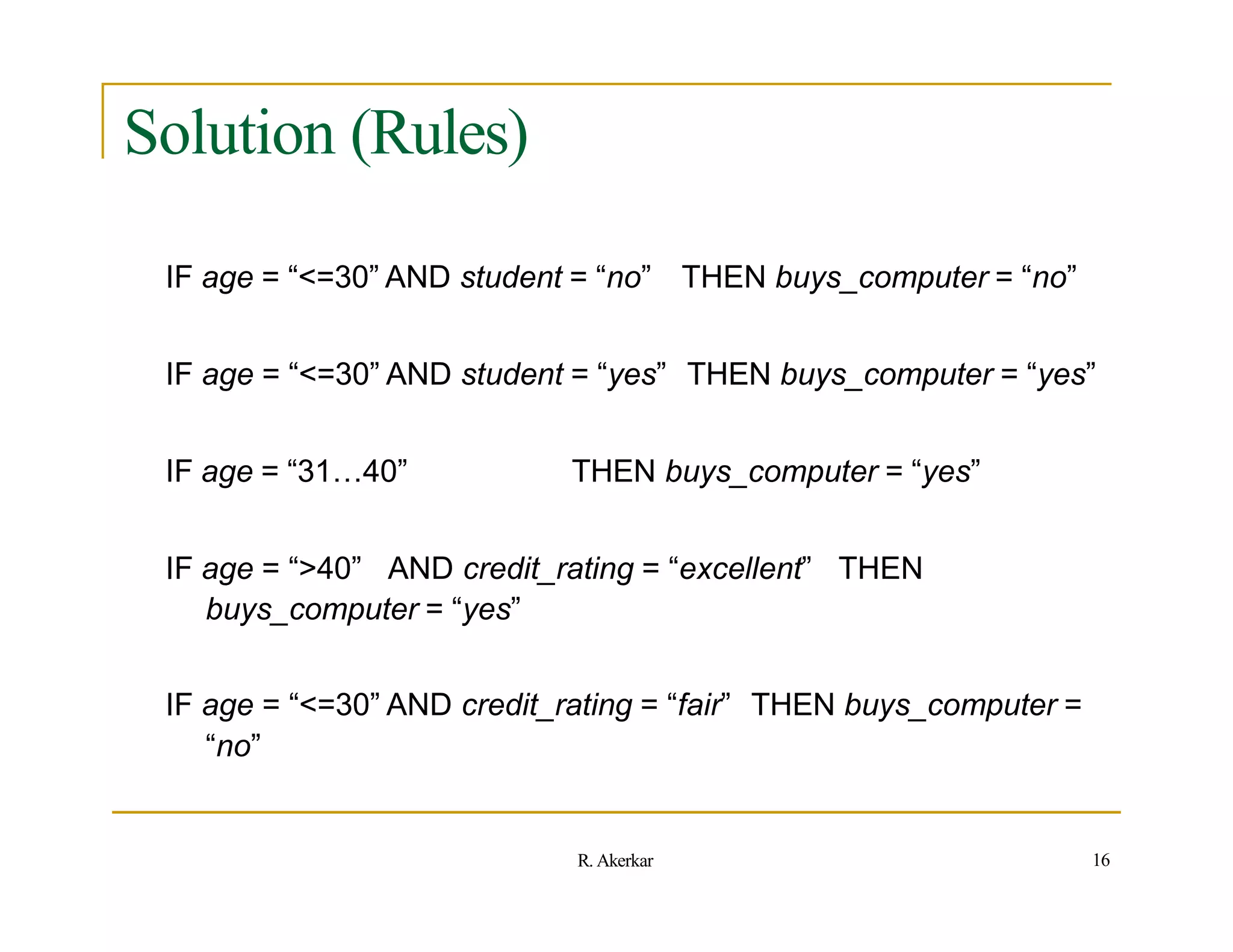
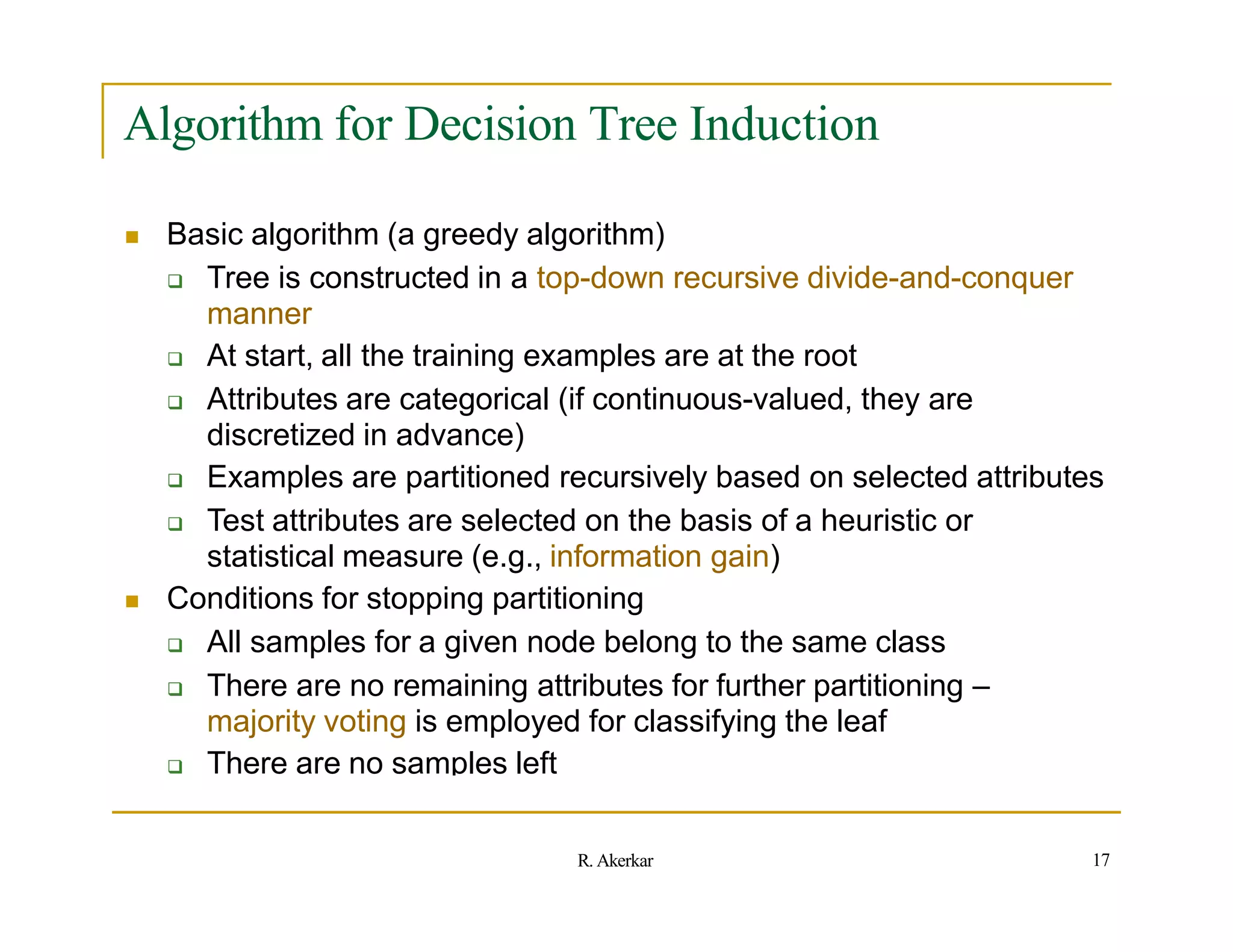
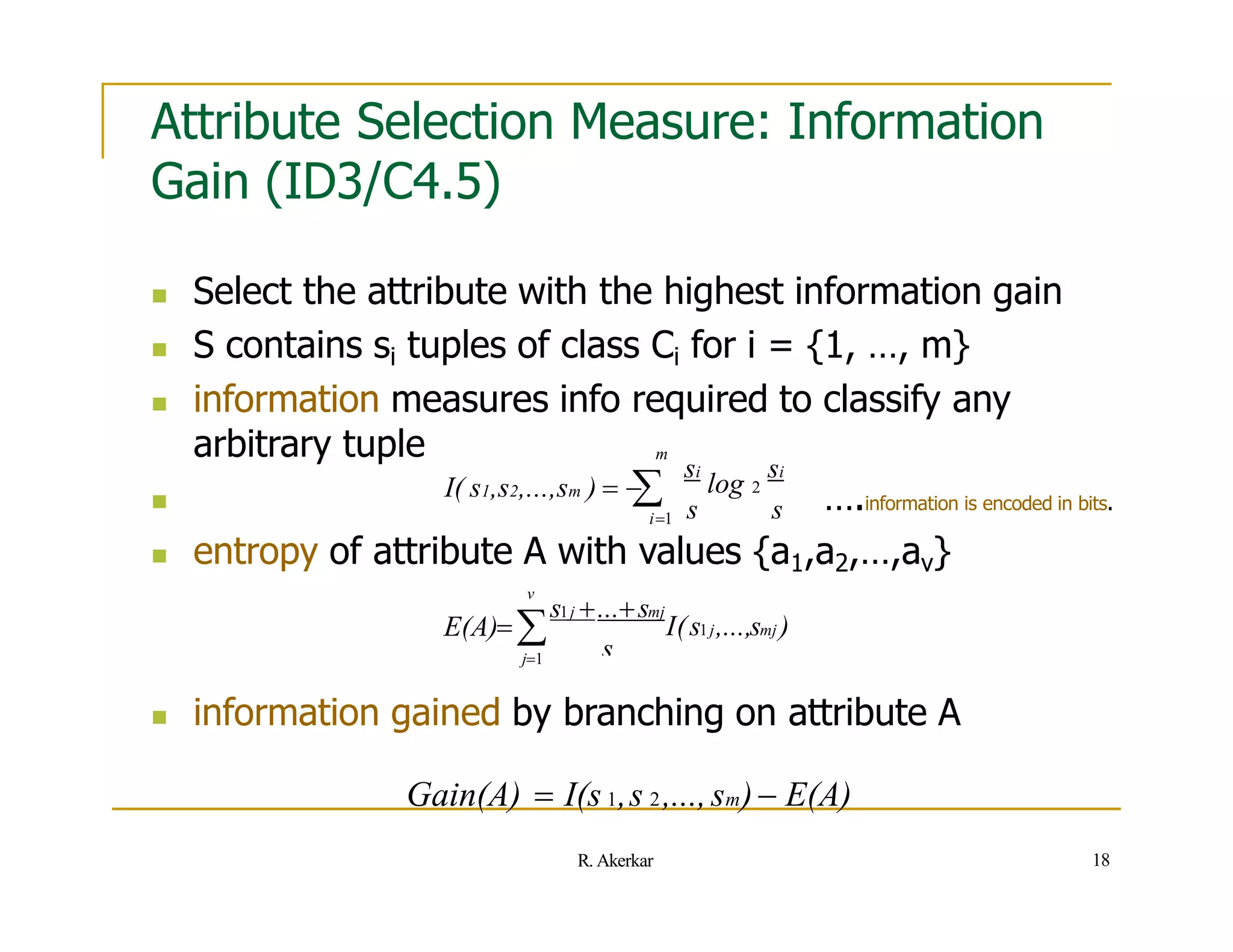
![Entropy
Entropy measures the homogeneity (purity) of a set of examples.
It gives the information content of the set in terms of the class labels of
the examples.
Consider that you have a set of examples, S with two classes, P and N. Let
the set have p instances for the class P and n instances for the class N.
So the total number of instances we have is t = p + n. The view [p, n] can
be seen as a class distribution of S.
The entropy for S is defined as
Entropy(S) = - (p/t).log2(p/t) - (n/t).log2(n/t)
Example: Let a set of examples consists of 9 instances for class positive,
and 5 instances for class negative.
Answer: p = 9 and n = 5.
So Entropy(S) = - (9/14).log2(9/14) - (5/14).log2(5/14)
= -(0.64286)(-0.6375) - (0.35714)(-1.48557)
= (0.40982) + (0.53056)
= 0.940
19
R. Akerkar](https://image.slidesharecdn.com/decisiontree-110906040745-phpapp01-221003171027-ec74db76/75/decisiontree-110906040745-phpapp01-pptx-19-2048.jpg)
![Entropy
The entropy for a completely pure set is 0 and is 1 for a set with
equal occurrences for both the classes.
i.e. Entropy[14,0] = - (14/14).log2(14/14) - (0/14).log2(0/14)
= -1.log2(1) - 0.log2(0)
= -1.0 - 0
= 0
i.e. Entropy[7,7] = - (7/14).log2(7/14) - (7/14).log2(7/14)
= - (0.5).log2(0.5) - (0.5).log2(0.5)
= - (0.5).(-1) - (0.5).(-1)
= 0.5 + 0.5
= 1
20
R. Akerkar](https://image.slidesharecdn.com/decisiontree-110906040745-phpapp01-221003171027-ec74db76/75/decisiontree-110906040745-phpapp01-pptx-20-2048.jpg)
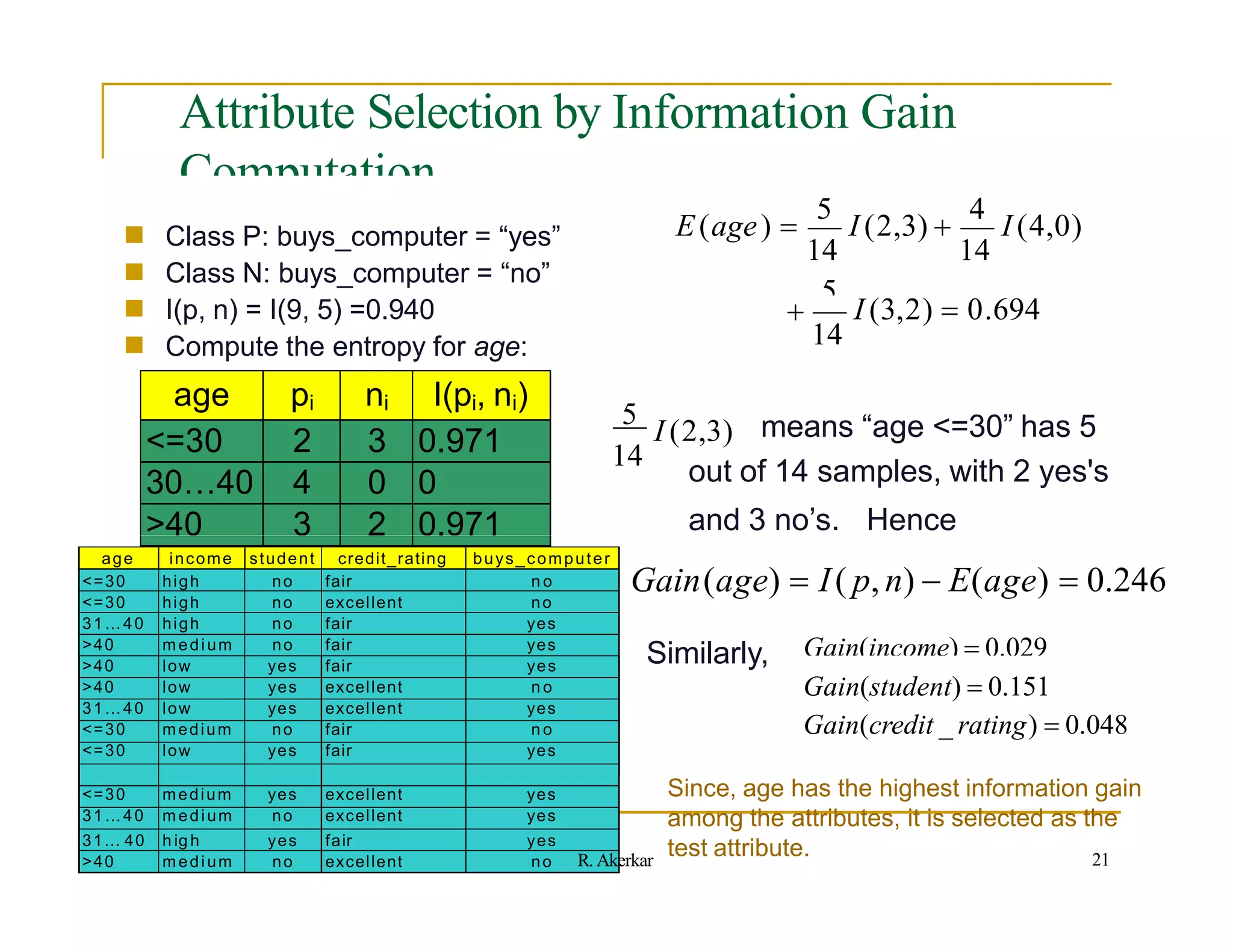
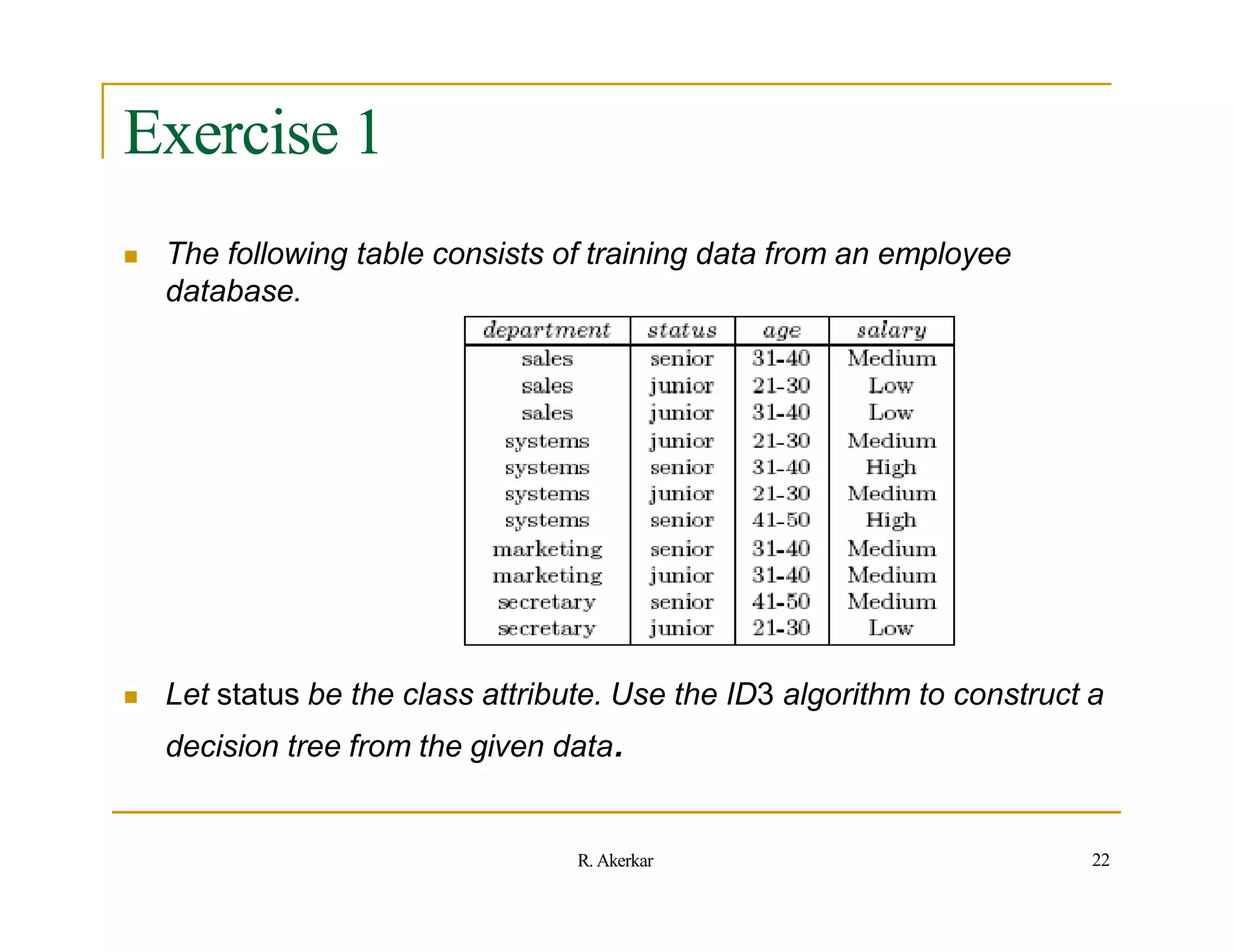


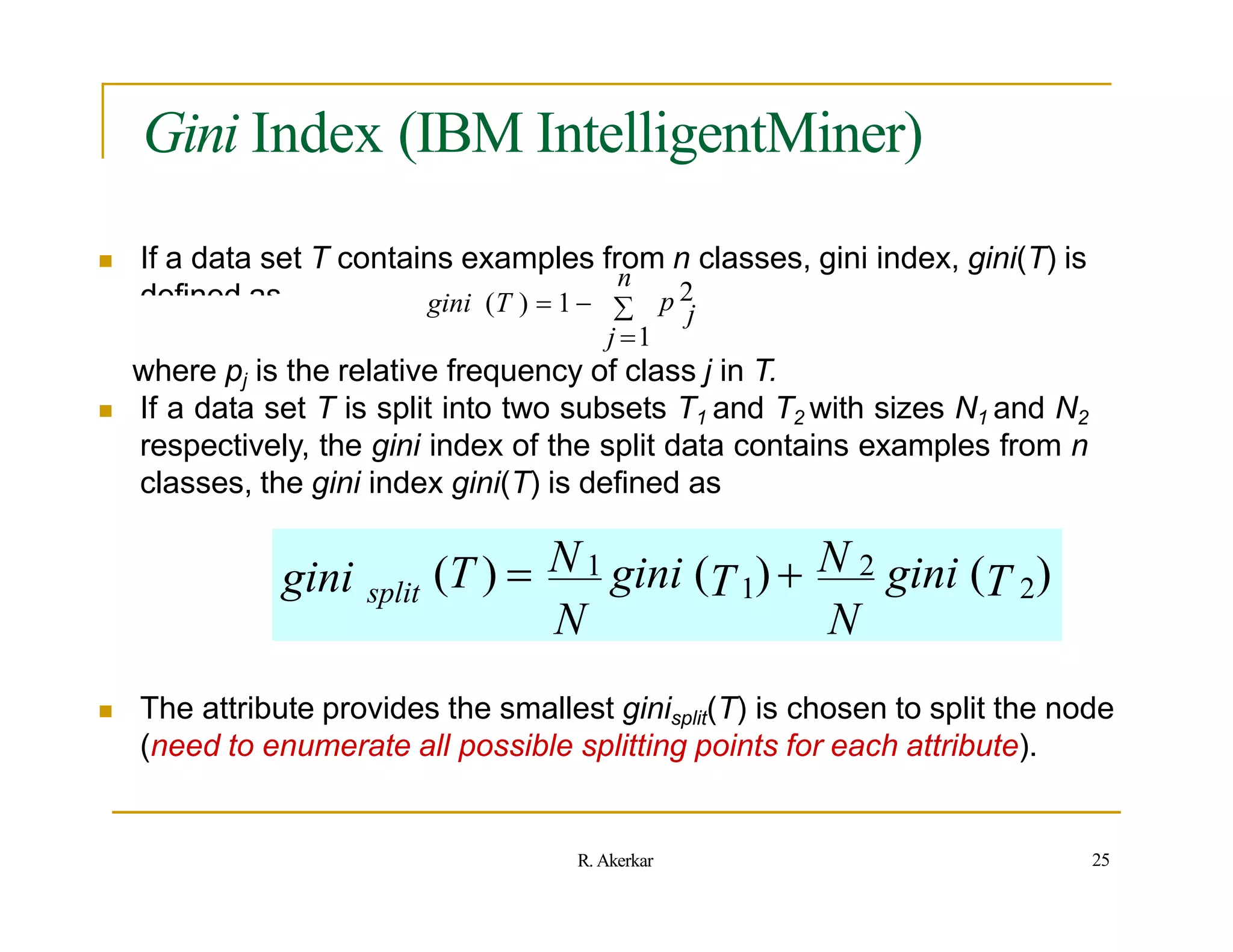
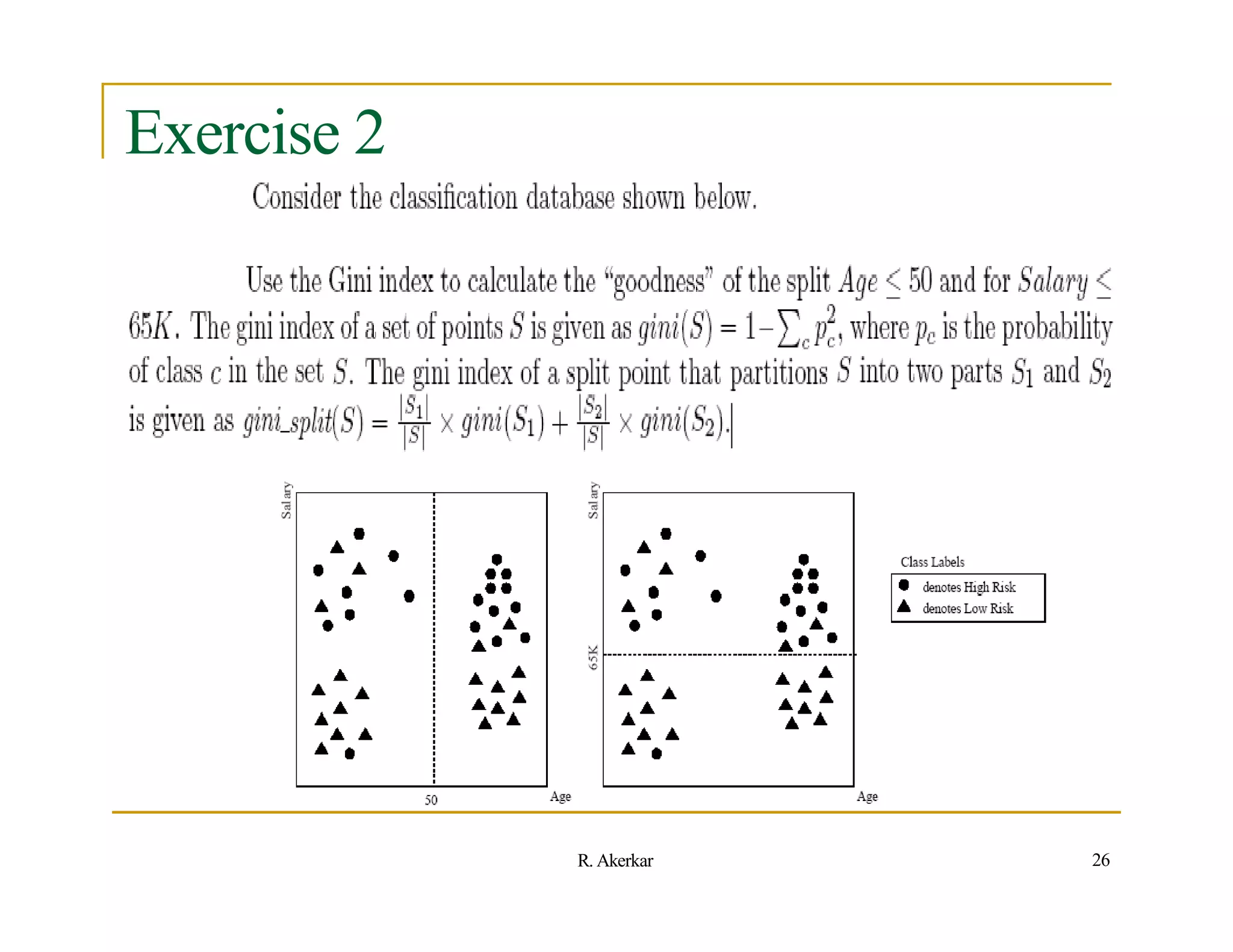
![Solution 2
SPLIT: Age <= 50
----------------------
| High | Low | Total
--------------------
S1 (left) | 8 | 11 | 19
S2 (right) | 11 | 10 | 21
For S1: P(high) = 8/19 = 0.42 and P(low) = 11/19 = 0.58
For S2: P(high) = 11/21 = 0.52 and P(low) = 10/21 = 0.48
Gini(S1) = 1-[0.42x0.42 + 0.58x0.58] = 1-[0.18+0.34] = 1-0.52 = 0.48
Gini(S2) = 1-[0.52x0.52 + 0.48x0.48] = 1-[0.27+0.23] = 1-0.5 = 0.5
Gini-Split(Age<=50) = 19/40 x 0.48 + 21/40 x 0.5 = 0.23 + 0.26 = 0.49
SPLIT: Salary <= 65K
----------------------
| High | Low | Total
--------------------
S1 (top) | 18 | 5 | 23
S2 (bottom) | 1 | 16 | 17
--------------------
For S1: P(high) = 18/23 = 0.78 and P(low) = 5/23 = 0.22
For S2: P(high) = 1/17 = 0.06 and P(low) = 16/17 = 0.94
Gini(S1) = 1-[0.78x0.78 + 0.22x0.22] = 1-[0.61+0.05] = 1-0.66 = 0.34
Gini(S2) = 1-[0.06x0.06 + 0.94x0.94] = 1-[0.004+0.884] = 1-0.89 = 0.11
Gini-Split(Age<=50) = 23/40 x 0.34 + 17/40 x 0.11 = 0.20 + 0.05 = 0.25
27
R. Akerkar](https://image.slidesharecdn.com/decisiontree-110906040745-phpapp01-221003171027-ec74db76/75/decisiontree-110906040745-phpapp01-pptx-27-2048.jpg)
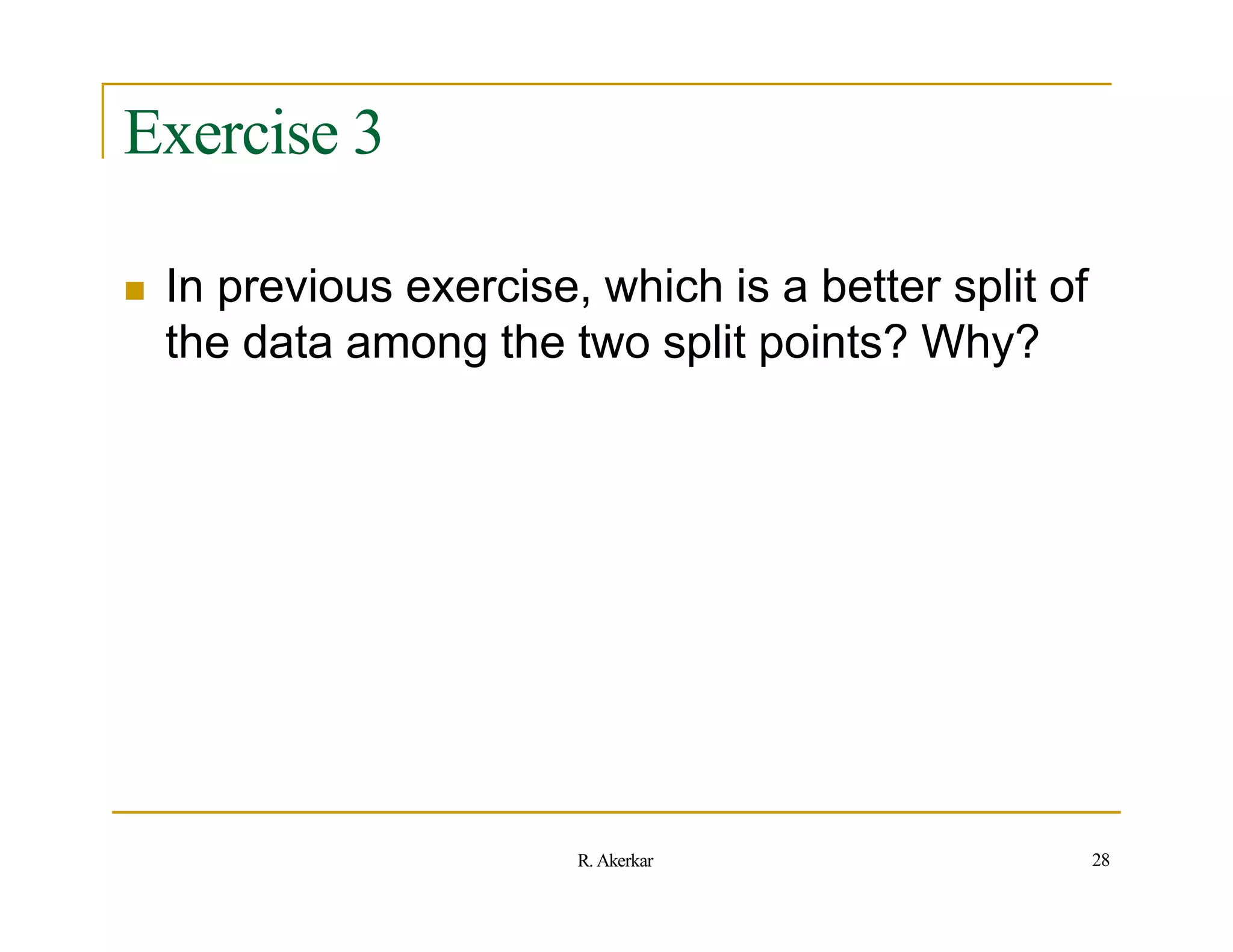
![Solution 3
``
Intuitively Salary <= 65K is a better split point since it produces
relatively pure'' partitions as opposed to Age <= 50, which
results in more mixed partitions (i.e., just look at the distribution
of Highs and Lows in S1 and S2).
More formally, let us consider the properties of the Gini index.
If a partition is totally pure, i.e., has all elements from the same
class, then gini(S) = 1-[1x1+0x0] = 1-1 = 0 (for two classes).
On the other hand if the classes are totally mixed, i.e., both
classes have equal probability then
gini(S) = 1 - [0.5x0.5 + 0.5x0.5] = 1-[0.25+0.25] = 0.5.
In other words the closer the gini value is to 0, the better the
partition is. Since Salary has lower gini it is a better split.
29
R. Akerkar](https://image.slidesharecdn.com/decisiontree-110906040745-phpapp01-221003171027-ec74db76/75/decisiontree-110906040745-phpapp01-pptx-29-2048.jpg)
